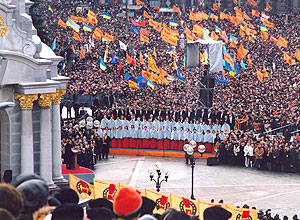- About Ukraine
- The Name of the State
- Geographic Situation
- The Land
- Natural Resources
- The Seas and Inland Waters
- The Climate
- The Flora
- The Fauna
- Administrative and Territorial Organization
- The Population
- Kyiv
- Folk art from Ukraine
- Love Ukraine
- Ivano-Frankivsk region
- Hutsuliya
- Rest and Tourism
- Photograph Album
- Library
- Feed
- Store
In terms of population (on 5.12.2005 — 48, 5 million people) Ukraine occupies the fifth place in Europe (after Germany, Italy, UK and France) and 21st in the world. It’s share 7% of European population and less than 1% of world population.
The general census of population in 2001 established that 32,6 million people live in cities and towns (67,2%) and 15,9 million (32,8%) — in villages. There are five cities in Ukraine that have populations of over million: Kyiv (2 million and 611 thousand), Kharkiv (1 million and 470 thousand), Dnipropetrovsk (1 million and 65 thousand), Donetsk (1 million and 16 thousand) and Odesa (1 million and 29 thousand).
Some large cities together with attached towns and villages form agglomerates. The largest among them are those of Kyiv, Zaporizhia, Kharkiv and others. The largest concentration of population lives in Donetsk (90%), Dnipropetrovsk (83%), Lugansk (86%) and Kharkiv (79%) regions. The largest volumes of villagers live in Zakarpattia (63%), Chernivtsi (57%), Ivano-Frankivsk (58%) and Vinnytsia (54%) regions.
Average density of population in Ukraine is 80 people per square kilometer, which is less than in many other European countries. The density and quantity of Ukrainian population was influenced in the past by the war with foreign occupants.
The density of population varies from region to region, the most densely populated being the eastern industrial regions, the least — in the northwest and in the south of the country (the least of all — in Chernigiv region — only 39 people per square km).
Ukraine is suffering from a demographic crisis. It’s population reached it’s maximum at the beginning of 1993 — 52 million 244 thousand people. The maximum decrease happened in 2001 — by 521,7 thousand people but recently an opposite process seems to be taking place. In 2003 the population decreased by 381 thousand people. This is due to a slight increase in the birth rate (even though the death rate is still higher) and a decrease in emigration.
Because of an improvement in the living standards of Ukrainian people it can be hoped that the birth rate will increase further and will be able to cover the now stabilized death rate. It is impossible to determine when depopulation will stop but the positive tendency is present. Life expectancy is one of the generalizing determinants of the living standards and it is influenced by various factors — the quality of medical services, material wealth, and way of life and genes. It varies between men women and men, as women are physically predisposed to live longer and generally have less bad habits. Between 1990 and 2002 life expectancy of women fell from 74,9 years to 74,1, of men — from 65,6 years to 62,7. As a consequence the difference in average life expectancy of men and women increased from 9,3 to 11,4 years.
Life expectancy of Ukrainian men is the lowest in Central-East Europe (except Russia and Kazakhstan), whereas the highest in Europe is that of Czech, Swedish and Icelandic men. The percentage of Ukrainians living in Ukraine was 77,8% in 2001. Now 37 millions and 541 thousand Ukrainians live here.
There are millions of Ukrainians all over the world — over 11 million in Russia, over 2 million in USA and over a million in each in Canada, Kazakhstan and Bilorussia. Large numbers, also, like in countries like Moldova, Brazil, Poland, Argentina, Romania, Uzbekistan, Israel, Hungary and Georgia.

Ukrainians are one of the largest nations in Europe and the second largest Slavic nation. Restoration of Ukrainian independence in 1991 is assisting the consolidation of Ukrainians, development of their national conscience, and grouping around the historic motherland.
Millions of people of other nationalities live in Ukraine (22,2% of the whole population). Russians form the largest national minority — 17,3% of the population. They live in many different areas of Ukraine but the majority — in the eastern regions and mostly in the cities. Russians have plenty of opportunities to satisfy their national spiritual needs. Russian language is widely spoken, especially in large industrial cities.
Moldavians live in the southwest of Ukraine, mostly in rural areas and their number reaches 258,6 thousand people. Another large minority is Bilorussian — 275,8 thousand people and is spread throughout Donbas, Rivne, Dnipropetrovsk and Kharkiv regions as well as Crimea.
There are large numbers of Crimean Tatars in Ukraine; their number growing to 248,2 thousand in 2001 but the process of their return to the motherland is not yet completed. From the ancient times Jews have lived in Ukraine. According to 2001 census there are 103,6 thousand living mostly in cities. The Association of Jewish organizations and communities unite 120 of them, all wide regional networks.
151 thousand Romanians live mostly in Chernivtsi and Zakarpattia regions. In the rural parts of Odessa, Zaporizhya and Donetsk regions live about 205 thousand Bulgarians. The only national minority in Ukraine in which the process of acculturation is (144 thousand people, living mostly in the western regions like Zhytomyr, Khmelnytskyy, Lviv, Vinnytsia regions). The Cultural and educational role of Poles is very active and there are over a hundred schools that teach Polish in the western regions.
Hungarians (163 thousand) live mostly in Zakarpattia region, whereas 92 thousand Greeks living predominantly in Pryazovya and Zaporizhya regions and Crimea. There is an active Federation of Greek societies of Ukraine and some national educational establishments were created.
Including the mentioned national minorities, there are many Armenians, Germans and Azerbaijani in Ukraine.
Ukrainian Constitution guarantees the development of ethnic, cultural, language and religious independence of both the native people and the national minorities.

